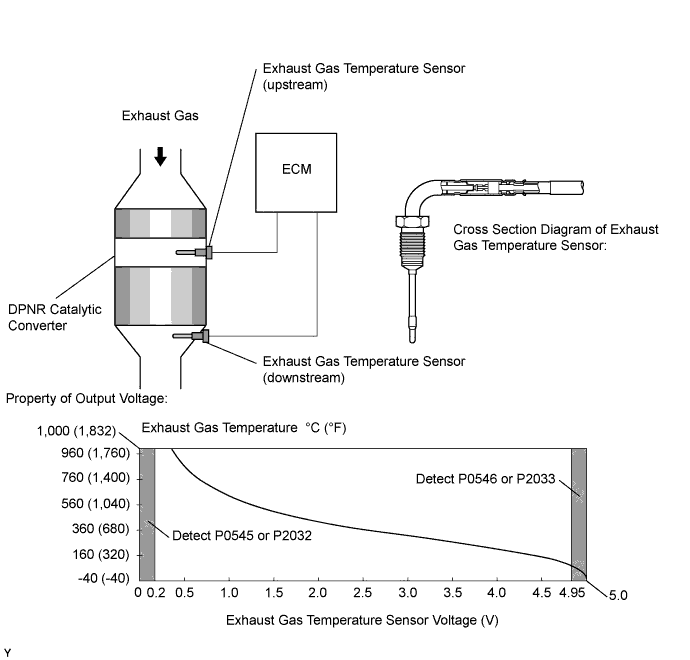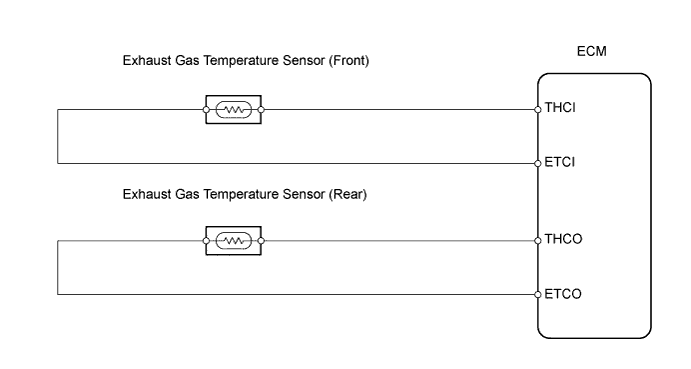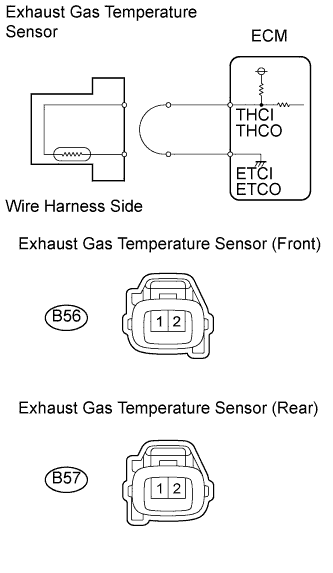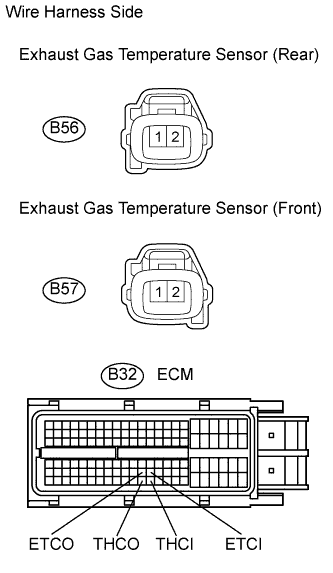DTC P0544 Exhaust GAS Temperature Sensor Circuit (Bank 1 Sensor 1)
DTC P0545 Exhaust Gas Temperature Sensor Circuit Low (Bank 1 Sensor 1)
DTC P0546 Exhaust Gas Temperature Sensor Circuit High (Bank 1 Sensor 1)
DTC P2031 Exhaust Gas Temperature Sensor Circuit (Bank 1 Sensor 2)
DTC P2032 Exhaust Gas Temperature Sensor Circuit Low (Bank 1 Sensor 2)
DTC P2033 Exhaust Gas Temperature Sensor Circuit High (Bank 1 Sensor 2)
Description

The exhaust gas temperature sensors are installed before and after the DPNR* catalytic converter to sense the exhaust gas temperature.
A thermistor built into the sensor changes its resistance value according to the exhaust gas temperature. The lower the exhaust gas temperature, the greater the thermistor resistance value. The greater the exhaust gas temperature, the lower the thermistor resistance value.
The exhaust gas temperature sensor is connected to the ECM. The 5 V power source voltage in the ECM is applied to the exhaust gas temperature sensor from terminal THCI (upstream) and THCO (downstream) via resistor R.
The resistor R and the exhaust gas temperature sensor are connected in series. When the resistance value of the exhaust gas temperature sensor changes in accordance with changes in the exhaust gas temperature, the voltage at terminals THCI (upstream) and THCO (downstream) also change. Based on these signals, when DPNR catalyst regeneration is needed, the ECM operates the exhaust fuel addition injector to obtain target upstream temperature of the DPNR catalytic converter as mentioned through sensor 1. In addition, the ECM monitors the rate of DPNR catalytic converter temperature increase using sensor 2.
HINT:
*: Diesel Particulate-NOx Reduction system.
Toyota fault code list DTC P0544 DTC P0545 DTC P0546 DTC P2031 DTC P2032 DTC P2033
| DTC No. | DTC Detection Condition | Trouble Area |
| P0544 | Sensor 1 output is less than 0.2 V or more than 4.95 V for 3 seconds or more (1 trip detection logic) |
|
| P0545 | Sensor 1 output is less than 0.2 V for 3 seconds or more (1 trip detection logic) |
|
| P0546 | Sensor 1 output is more than 4.95 V for 3 seconds or more (1 trip detection logic) |
|
| P2031 | Sensor 2 output is less than 0.2 V or more than 4.95 V for 3 seconds or more (1 trip detection logic) |
|
| P2032 | Sensor 2 output is less than 0.2 V for 3 seconds or more (1 trip detection logic) |
|
| P2033 | Sensor 2 output is more than 4.95 V for 3 seconds or more (1 trip detection logic) |
HINT:
- DTC P1386 (Exhaust fuel addition injector malfunction) will be present if there is an open malfunction in an exhaust gas temperature sensor circuit.
- Sensor 1 represents a sensor located upstream on the DPNR catalytic converter.
- Sensor 2 represents a sensor located downstream on the DPNR catalytic converter.
- After confirming DTC P0544, P0545, P0546, P2031, P2032, and P2033, check the upstream and downstream exhaust gas temperature in the "Powertrain / Engine and ECT / Initial Exhaust Temp (IN) and Initial Exhaust Temp (OUT)" menu using the intelligent tester.
| Condition | Exhaust Gas Temperature | Exhaust Gas Temperature Sensor Condition |
| Idling after warm-up | Constant at 50 to 700°C (122 to 1,292°F) | Normal |
| 0°C (32°F) | Short circuit | |
| 1,000°C (1,832°F) | Open circuit |
Monitor description
The ECM constantly monitors the output voltages from the sensors in order to detect problems with the sensors. When the sensor output voltage deviates from the normal operating range (between 0.2 V and 4.95 V) for more than 3 seconds after the engine is warmed up, the ECM interprets this as malfunction of the sensor circuit, and illuminates the MIL.
Wiring diagram

Inspection procedure
NOTICE:
After replacing the ECM, the new ECM needs registration and initialization.
| 1.READ VALUE OF EXHAUST GAS TEMPERATURE SENSOR |
-
Connect the intelligent tester to the DLC3.
-
Turn the ignition switch on (IG) and turn the tester ON.
-
Enter the following menus: Powertrain / Engine and ECT / Initial Exhaust Temp (IN) and Initial Exhaust Temp (OUT).
-
Read the value.
OK:
Same as the actual exhaust gas temperature (50 to 700°C [122 to 1,292°F] during idling after warm-up), and varies after an engine speed of 3,000 rpm is maintained for 1 minute.
Result:Temperature Displayed Proceed to 1,000°C (1,832°F) A 0°C (32°F) (After warming up the engine) B Same as the actual exhaust gas temperature (50 to 700°C [122 to 1,292°F] during idling after warm-up), and varies after maintaining the engine speed of 3,000 rpm for 1 minute after accelerating the engine from idling to 3,000 rpm C HINT:
- If there is a short circuit, the tester will indicate 0°C (32°F).
- If there is an open circuit, the tester will indicate 1,000°C (1,832°F).
|
|
||||
|
|
||||
| A | |
| 2.CHECK WIRE HARNESS (CHECK FOR OPEN IN WIRE HARNESS) |

-
Disconnect the B56 or B57 exhaust gas temperature sensor connector.
-
Connect terminals 1 and 2 of the exhaust gas temperature sensor wire harness side connector.
-
Connect the intelligent tester to the DLC 3.
-
Turn the ignition switch on (IG) and turn the tester ON.
-
Enter the following menus: Powertrain / Engine and ECT / Initial Exhaust Temp (IN) and Initial Exhaust Temp (OUT).
-
Read the value.
Standard value:
0°C (32°F)
-
Reconnect the exhaust gas temperature sensor connector.
|
|
||||
| NG | |
| 3.CHECK WIRE HARNESS (EXHAUST GAS TEMPERATURE SENSOR - ECM) |

-
Disconnect the B56 or B57 exhaust gas temperature sensor connector.
-
Disconnect the B32 ECM connector.
-
Measure the resistance of the wire harness side connectors.
Standard resistance:
Tester Connection Specified Condition B56-2 - B32-122 (THCI)
or
B57-2 - B32-121 (THCO)Below 1 ? B56-1 - B32-99 (ETCI)
or
B57-1 - B32-98 (ETCO)Below 1 ? -
Reconnect the exhaust gas temperature sensor.
-
Reconnect the ECM connector.
|
|
||||
| NG | |
|
| 4.READ VALUE OF INTELLIGENT TESTER (CHECK FOR SHORT IN WIRE HARNESS) |

-
Disconnect the B56 or B57 exhaust gas temperature sensor connector.
-
Connect the intelligent tester to the DLC3.
-
Turn the ignition switch on (IG) and turn the tester ON.
-
Enter the following menus: Powertrain / Engine and ECT / Initial Exhaust Temp (IN) and Initial Exhaust Temp (OUT).
-
Read the value.
Standard value:
0°C (32°F)
-
Reconnect the exhaust gas temperature sensor connector.
|
|
||||
| NG | |
| 5.CHECK WIRE HARNESS (EXHAUST GAS TEMPERATURE SENSOR - ECM) |

-
Disconnect the B56 or B57 exhaust gas temperature sensor connector.
-
Disconnect the B32 ECM connector.
-
Measure the resistance of the wire harness side connectors.
Standard resistance:
Tester Connection Specified Condition B56-2 or B32-122 (THCI) - Body ground
B56-2 or B32-121 (THCO) - Body ground10 k? or higher -
Reconnect the exhaust gas temperature sensor connector.
-
Reconnect the ECM connector.
|
|
||||
| NG | |
|